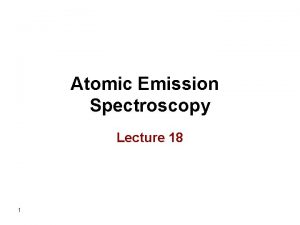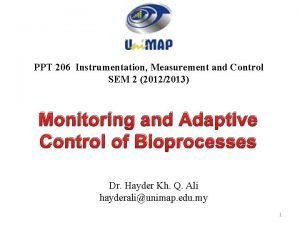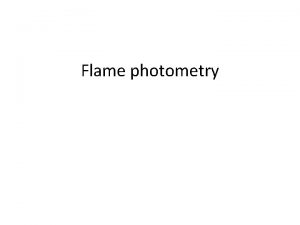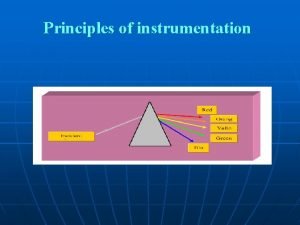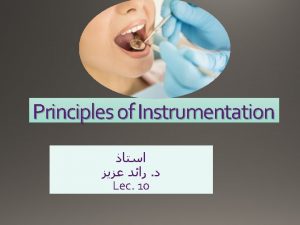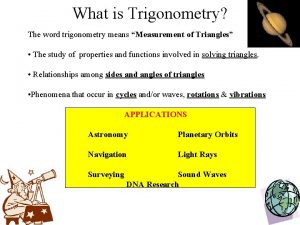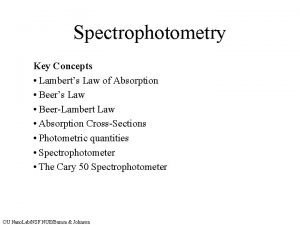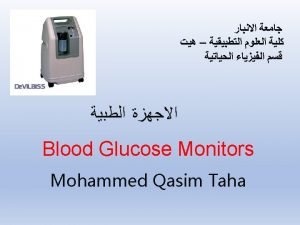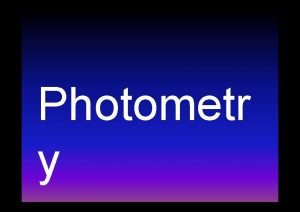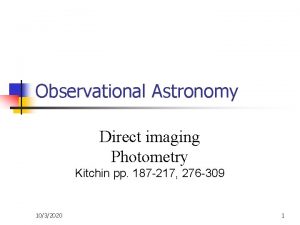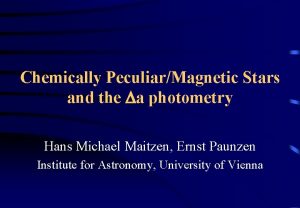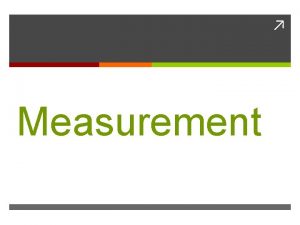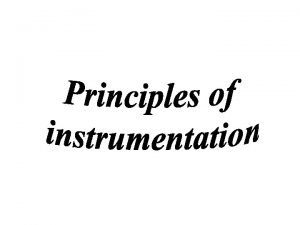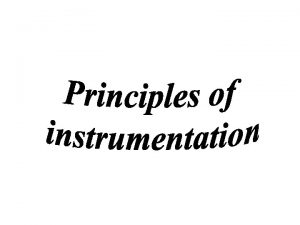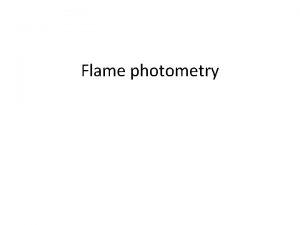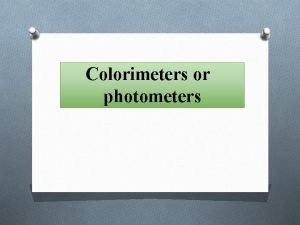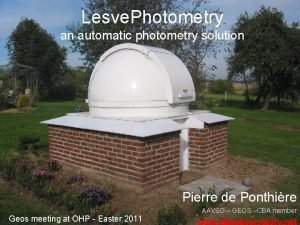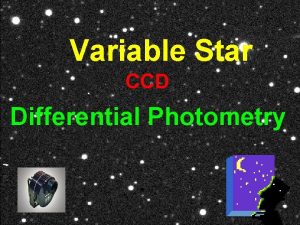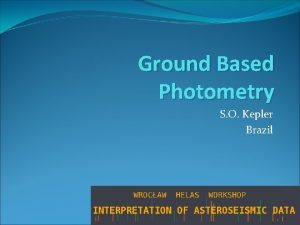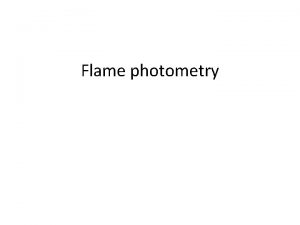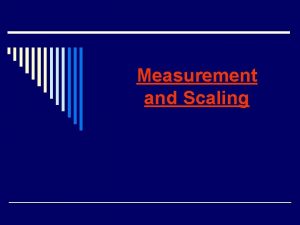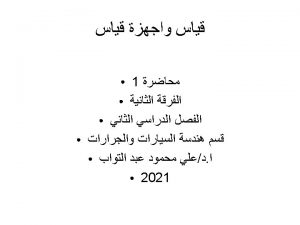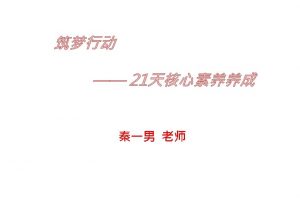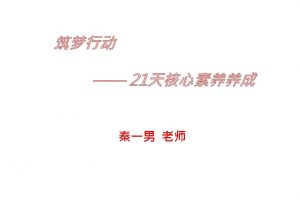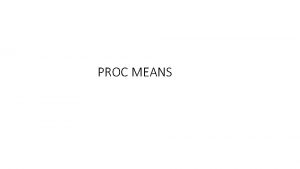Principles of instrumentation Photometry Photometry means the measurement




















- Slides: 20

Principles of instrumentation

Photometry -Photometry means “the measurement of light” If a substance can be converted to a soluble, colored material, its concentration may be determined by the amount of color present in the solution. - Photometer & Spectrophotometer are instruments used for this type of measurement, in which a photocell or photomultiplier tube is used to detect the amount of light that passes through a colored solution from a light source. - The greatest sensitivity is obtained when the light permitted to pass through the solution is of a particular wavelength. (The wavelength shows the maximum absorbance for the solution color).

Characteristics of Light 1 - Light is a form of electromagnetic energy that travels in waves. 2 -The wavelength of light is the distance between two beaks of the light wave, is inversely proportional with its energy. 3 - In the visible region the color of light is a function of its wave ngth increasing from violet towards the red color ength 4 - Objects that appear colored absorb light at particular wavelength and reflect the other parts of the visible spectrum resulting in many shades of color.

example: a substance that absorbs violet light at 400 nm reflects all other light and appears as yellow green. - Spectrophotometer takes advantage of the property of colored solutions to absorb light of specific wavelength. - To measure the concentration of a blue solution, light is passed through it at about 590 nm. The amount of yellow light absorbed varies directly in proportion to the concentration of the blue substances in the solution.

Gamma < 0. 1 X-rays 0. 1 -10 Ultraviolet <380 Visible 380 -750 Infrared >750 radiowaves >25 x 107 Wavelength Approximately wavelength gy Types of radiation Ener Table-1(wavelengths of various types of Radiation)

Table – 2 (the visible Spectrum) Approximately wavelength Color of absorbed light Color of reflected light 400 -435 Violet Green–Yellow 435 -500 Blue Yellow 500 -570 Green Red 570 -600 Yellow Blue 600 -630 Orange 630 -700 Red Green blue Green

Beer’s law When the light of an appropriate wavelength strikes a cuvet that contains a colored sample, some of the light is absorbed and the rest is transmitted through the sample to the detector. % percent transmittance which represents the proportion of light reaches the detector. % T = It Io x 100 % Where: e intensity of light striking the sample. intensity of transmitted ght.

Beer’s law - If the concentration of a solution is increased, the It will decrease and then % T is decreased. - The relationship between the concentration and %T is not linear, but if the logarithm of the %T is plotted against the concentration, a straight line is obtained (fig 1) -The term absorbance is used to represent – log % T A = - log % T = 1/ log % T

Beer-Lambert Law A=abc Which states that “the absorbance of a solution is directly proportional with the concentration of the dissolved substance” Where: - A is the absorbance - a is the molar absorptivity coefficient( )ﻣﻌﺎﻣﻞ ﺍﻻﻣﺘﺼﺎﺹ ﺍﻟﻤﻮﻟﻴﺔ - b is the light bath through a solution( ﺍﻟﻤﺴﺎﻓﺔ ﺍﻟﺘﻲ ﻗﻄﻌﻬﺎ ﺍﻟﻀﻮﺀ ﺧﻼﻝ ﺍﻟﻤﺎﺩﺓ For x substance: Ax = a b cx For standard substance: Ast = a b cst (1) (2)

Then we can determine the concentration of x substance by measuring both sample and standard absorbance, which can be made by spectrophotometers.

UV – Visible photometry Typical coloremetric instruments contain five components: 1 - Stable source of radiation energy. 2 - A transparent container for holding the sample. A device that isolates a restricted region of the spectrum for measurement. radiation detector which converts radiant energy to electrical signals. 5 -- A signal processor and read out which displays udated signals, a meter scale, a digital meter or a recorder chart.

UV – Visible photometry

1 - Radiation sources - In UV region: The most commonly used is deuterium lamp or hydrogen lamp. n In which a continues spectrum is produced by the excitation of deuterium (D 2) or hydrogen at law pressure, and then produced light with (160 -375) nm. n - In visible region: § Tungeston filament lamp is the most commonly used and produces light at (350 -2500) nm.

2 - Wavelength selectors A- Filters: • Formed of a transparent dielectric layer such as calcium fluoride, the thickness of this layer is controlled carefully and determines the wave length of transmitted light. • Or formed of colored glass that absorbs certain portions of spectrum and transmits others, according to its color. 1 - Grating monochromator: • Grooves formed of relatively broad faces and narrow unused face

2 - Prism Principle: Suppose a radiation of 2 wave length enter from the entrance slit, they strike the mirror to be reflected on the dispersing element to produce angular dispersion of light which face a black surface and come out from the exit slit only, by moving monochromator, a specific wave length will pass from the exit slit. - For prism by moving it only one will exit -

Note: Colorimeters Photometers Spectrophotometer - Used filters as wavelength selector - Used monochromators as Wavelength selector

3 - Sample containers - Cuvetes that hold the samples must be made of material that passes radiation in the spectral region of interest. - Quartz or fused silica may be used in the spectral region (350 -3000 nm), mean it may be used in the UV, visible and a part of infrared. - Silicated glass used in (350 - 2000 nm) region. - Plastic is used in the visible region 4 - Radiation detectors and read out Phototubes Photomultiplier tube Photoconductivity detector silicon diode electrode

- - One of them may be used to transform radian energy into electrical energy. Which may be measured by galvanometer or any read out device. Principle of phototube: Photoemissive cathode that tends to emit electrons when irradiated. These electrons flow to the anode generating current.

General Types of UV-Visible colorimeters A- Photometers (Nondispersive): Which use filters as wavelength selector, which may be:

General Types of UV-Visible colorimeters B- Spectrophotometers (dispersive): Used Monochromator as wavelength selector.
 Flame photometry instrumentation
Flame photometry instrumentation Fundamentals of instrumentation and measurement ppt
Fundamentals of instrumentation and measurement ppt Photometry principle
Photometry principle Coloremetric
Coloremetric Standard pen grasp
Standard pen grasp What is triginometry
What is triginometry Beers and lambert law
Beers and lambert law Reflectance photometry principle
Reflectance photometry principle Iraf imexamine
Iraf imexamine Photometry
Photometry Photometry
Photometry Poly and gon
Poly and gon Meta'' means morphe'' means
Meta'' means morphe'' means Meta means in metamorphism
Meta means in metamorphism Define biodiversity conservation
Define biodiversity conservation Life bio
Life bio Hình ảnh bộ gõ cơ thể búng tay
Hình ảnh bộ gõ cơ thể búng tay Frameset trong html5
Frameset trong html5 Bổ thể
Bổ thể Tỉ lệ cơ thể trẻ em
Tỉ lệ cơ thể trẻ em Gấu đi như thế nào
Gấu đi như thế nào
